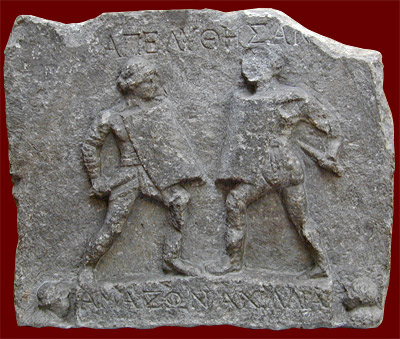 Amazon & Achillia, marble, Halicarnassus 1-2 century CE |
|
|||||||||||
|
Games featuring male gladiators were widespread and long popular in Rome, where the last gladiatorial combats took place in the Colosseum in 404 CE. Although we do not know where they came from or what training they received, the presence of female gladiators in the Roman Empire in the first centuries CE is evidenced in scattered texts, edicts (the Senatus Consultum of 19 CE), and material remains (see the topless bronze gladiatrix in Hamburg). For further information click on essay by Murray; see article by McCullough (pp. 954-63 in Budin & Turfa) in Bibliography. |
||||||||||||
The earliest appearance of female gladiators is generally thought to date to 63 CE, when, Tacitus writes, a certain Patrobius arranged games on behalf of Nero to honor Tiridates, the former king of Armenia; the games were full of unusual offerings, including women warriors. In Petronius’ Satyricon, the rag dealer Echion enthusiastically turns the conversation during Trimalchio’s dinner to the unusual gladiatorial shows about to take place, in which plurimi liberti are contestants and there is a woman chariot fighter.
| spectacula gladiatorum idem annus habuit pari magnificentia ac priora; sed feminarum |
| inlustrium senatorumque plures per arenam foedati sunt. |
|
Iam Manios aliquot habet et mulierem essedariam et dispensatorem Glyconis, qui |
|
deprehensus est cum dominam suam delectaretur. Videbis populi rixam inter |
|
zelot et amasiunculos. Glyco autem, sestertiarius homo, dispensatorem ad bestias |
|
dedit. Hoc est se ipsum traducere. Quid servus peccavit, qui coactus est facere? |
Domitian was not content to attend the Praetor’s games; he offered additional games in his own name, striving to make them popular by introducing novelties, such as holding them at night or pairing dwarf gladiators in combat. Three writers give witness to the presence of women in Domitian’s program of games: Suetonius, who mentions this fact in his Life of Domitian; Martial, who wrote two epigrams in elegiac meter alluding to women in the arena in his book of poems celebrating the opening of the Flavian Amphitheater (80 C); Statius, who marvels at women's warrior prowess in his epic poem, Silvae, written hendecasyllabic meter.
| Belliger invictis quod Mars tibi servit in armis, |
|
non satis est, Caesar; servit et ipsa Venus! |
| Prostratum vasta in valle leonem |
| Prisca fides taceat! Nam post tua munera, Caesar, |
|
Spectacula assidue magnifica et sumptuosa edidit non in amphitheatro modo, verum et in circo, |
|
ubi praeter sollemnes bigarum quadrigarumque cursus, proelium etiam duplex, equestre ac |
|
pedestre, commisit; at in amphitheatro navale quoque. Nam venationes gladiatoresque et |
|
noctibus ad lychnuchos, nec virorum modo pugnas sed et feminarum. |
Click on the underlined words for translation aids and commentary, which will appear in a small window. Close this small window after each use.